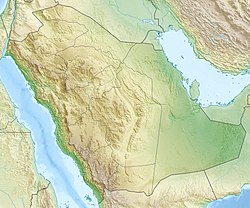Loading AI tools
Mustatils are prehistoric monuments made of sandstone walls which are found in northwest Saudi Arabia.
| Location | northwest Saudi Arabia |
|---|---|
| Coordinates | 25°52′54″N 39°23′38″E |
| Type | Monument |
| Length | 20–600 metres (66–1,969 ft) long |
| Height | 1.2 metres (3 ft 11 in) high |
| History | |
| Material | sandstone |
| Founded | Neolithic |
Named mustatil (Arabic: مستطيل, lit. 'rectangle', plural مُسْتَطِيلَات, mustaṭīlāt) for their shape, they have walls surrounding a long central courtyard, with a rubble platform at one end and entrances at the end opposite the platform. Some entrances are closed off with stones.[1][2]
Over 1,000 mustatils, clustered in groups of 2–19, are spread out across a ritual landscape covering 200,000 square kilometres. They range from 20 to over 600 metres in length, with walls that are 1.2 metres high. Some of the sandstone blocks used in their construction weigh more than 500 kilograms.[1][2][3]
The mustatils first came to the attention of researchers in the 1970s. Excavation of one mustatil funded by the Royal Commission for Al-'Ula revealed a chamber at the center containing fragments of cattle skulls, but no remains from other parts of the animals; they are believed to be evidence of a previously unknown cattle cult.[4]
Radiocarbon dating of the skulls revealed that the mustatil, and maybe the others, was built between 5300–5000 BCE, during the Holocene Humid Phase, a time when the area was a grassland that went through frequent droughts. This would make the mustatils one of the oldest-known large-scale ritual landscapes in the world.[1][3][4]
Wikiwand in your browser!
Seamless Wikipedia browsing. On steroids.
Every time you click a link to Wikipedia, Wiktionary or Wikiquote in your browser's search results, it will show the modern Wikiwand interface.
Wikiwand extension is a five stars, simple, with minimum permission required to keep your browsing private, safe and transparent.
